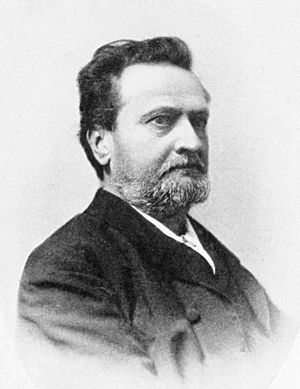Julius von Sachs facts for kids
Quick facts for kids
Julius von Sachs
|
|
|---|---|

Julius von Sachs
|
|
| Born | 2 October 1832 |
| Died | 29 May 1897 (aged 64) Würzburg, Kingdom of Bavaria
|
| Nationality | German |
| Alma mater | Charles University in Prague |
| Known for | Sachs' solution |
| Scientific career | |
| Fields | Botany |
| Institutions | University of Bonn University of Freiburg University of Würzburg |
| Influences | Jan Evangelista Purkyně |
Julius von Sachs (2 October 1832 – 29 May 1897) was a German botanist from Breslau. He is known as a founder of experimental plant physiology. This means he studied how plants work using scientific experiments.
Sachs also helped start modern hydroponics, which is growing plants without soil. He and Wilhelm Knop were important figures in the history of botany. They showed how important water culture was for studying how plants get their food. They also studied how plants grow and function in the 19th century.
Contents
Early Life and Education
Julius Sachs was born in Breslau on October 2, 1832. His father was an engraver, someone who carves designs. From a young age, Julius loved plants. He often went on trips with his father to collect them.
Between ages 13 and 16, he spent much time drawing and painting plants. He collected flowers, fungi, and other plant samples. At school, he was most interested in natural sciences. He even wrote a paper about crayfish.
When he was 16, his father died. The next year, his mother and brother also passed away. Julius was left without money. Luckily, he was taken in by the family of Jan Evangelista Purkyně. Purkyně was a professor at the University of Prague. Sachs started studying at the university in 1851.
Sachs worked very hard in Purkyně's lab. After his lab work, he spent many more hours studying on his own. He wanted to understand exactly how plants grow.
Julius von Sachs' Career and Discoveries
In 1856, Sachs earned his PhD. He then decided to focus on a career in botany. He became a private teacher of plant physiology. In 1859, he became a helper at the Agricultural Academy of Tharandt.
He then moved to the Agricultural Academy at Poppelsdorf in 1862. He stayed there until 1867. After that, he became a professor of botany at the University of Freiburg. In 1868, he became a botany professor at the University of Würzburg. He stayed there for the rest of his life.
Sachs was known as a great researcher, writer, and teacher. He greatly helped plant physiology grow in the late 1800s. He also contributed to many other areas of botany.
How Plants Grow: Germination and Nutrition
Sachs wrote many early papers about how plants sprout. These papers helped us understand how plants start to grow from seeds. He also brought back the method of "water-culture." He used it to study how plants get their food.
Understanding Photosynthesis
One of his most important discoveries was about photosynthesis. He showed that the tiny starch grains in plant leaves depend on sunlight. These starch grains are found in parts of the leaf called chloroplasts.
He did a famous experiment to prove this. He took a leaf that had been in sunlight. He then removed its green color and stained it with iodine. The leaf turned black, showing it contained starch. A leaf from the same plant that had been in the dark stayed white. This proved that sunlight helps plants make starch. You can see this experiment in the show "Botany: A Blooming History."
Measuring Plant Growth and Movement
Sachs also studied how plants grow in length. He invented a tool called the auxanometer. This device could automatically record how much a plant grew. He found that certain light rays could slow down plant growth.
He also researched how plants respond to light (heliotropism) and gravity (geotropism). For this, he used a device called a clinostat. This tool slowly rotates a plant to cancel out the effect of gravity.
Important Books by Sachs
Sachs wrote several important books. His first book was Handbuch der Experimentalphysiologie des Pflanzen (1865). It explained a lot about plant physiology.
In 1868, he published his famous Lehrbuch der Botanik. This book covered all of botany at the time. It also included many of his own discoveries. This book was translated into English in 1875.
Later, he wrote Vorlesungen uber Pflanzenphysiologie (1882). He also wrote Geschichte der Botanik (1875). This book told the story of how botany developed from the mid-1500s to 1860.
Views on Evolution
Julius von Sachs was a "post-Darwinian botanist." This means he lived and worked after Charles Darwin published his ideas on evolution. Sachs first supported Darwin's ideas. However, later in his life, he disagreed with them. He preferred other ideas about how living things change over time.
Sachs' Lasting Influence
Many of Sachs' students became famous botanists themselves. Some of them include Julius Oscar Brefeld, Francis Darwin, and Hugo de Vries.
His scientific ideas also influenced other scientists like Dennis Robert Hoagland. Hoagland helped create special nutrient solutions for plants. He used Sachs' ideas about how much and what kind of chemicals plants need. Sachs believed that the exact amounts of chemicals could vary a bit. What mattered was that the mix was generally good for the plant. This idea helped develop the important Hoagland solution used today.
The short name Sachs is used in plant names to show he described that species. For example, if you see a plant name like Plantus sachsii, it means Sachs helped name or describe it.
Two plant groups were named in his honor. In 1866, a plant genus called Sachsia was named after him. These plants are found in the West Indies and Florida. In 1895, a genus of fungi, also called Sachsia, was named after him.
Images for kids


